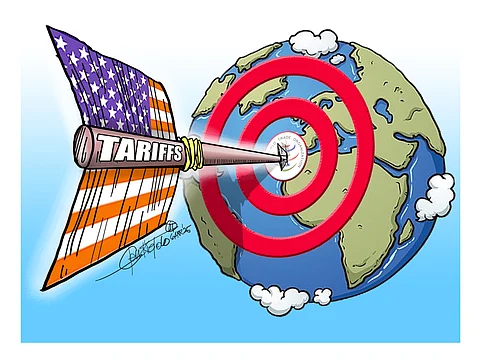
- NEWS
- the EDIT
- COMMENTARY
- BUSINESS
- LIFE
- SHOW
- ACTION
- GLOBAL GOALS
- SNAPS
- DYARYO TIRADA
- MORE

Beyond the target of reindustrializing the United States, the Liberation Tariff of US President Donald Trump appears to be a direct strike on the global trading system, particularly the World Trade Organization (WTO).
As with any other oversized global organization that Trump has lashed out at, the WTO has proved ineffective at controlling industrial subsidies, forced technology transfers, and intellectual property theft, especially in the case of China.
Trump has lashed out at the uneven trade relations between the US and other nations, particularly China.
Estimates are that between 1999 and 2011, rising import competition from China contributed to nearly one million manufacturing jobs lost and close to two million workers displaced across the US economy.
The United States has transitioned significantly toward services such as finance, healthcare, education, and technology as its economic growth engine.
Implementing a 17-percent tariff on Philippine exports as part of Trump’s “Liberation Day” thrust, effective 9 April, presents a formidable challenge.
At stake is about $12.1 billion in yearly exports to the US or about 16.6 percent of total products that the Philippines sold overseas in 2024.
Economists believe that amid the gloom is a window of opportunity that should be exploited by leveraging the country’s strategic position, adaptive capacity, and global relationships.
The tariff exposes a vulnerability in the country’s over-reliance on the US market. The realization of such weakness could accelerate trade diversification, a goal long discussed but not pursued seriously.
A pivot toward alternative markets like Japan, South Korea, the European Union and ASEAN, where demand for our key exports remains robust, is only logical.
The tariff offensive could thus be the push needed to unlock more markets, reducing the US’s bloated share of exports and insulating the Philippine economy from future unilateral shocks.
Under the new US tariff regime, Vietnam faces a 46-percent charge, China 34-percent, and Indonesia 32-percent.
At 17-percent, the Philippines enjoys a relative advantage, positioning it as a potential beneficiary, particularly in the supply chain realignment.
Cushioning the effects of the US tariff blitzkrieg, however, requires swift action through investments in logistics, manufacturing capacity and workforce skills.
Government incentives such as tax holidays and infrastructure upgrades could spark an inflow of foreign direct investment, turning a trade penalty into a competitive edge.
As one heavyweight economist said, “There will be bruising but no broken bones” for the country amid the trade tremor.
The Philippines, nonetheless, can use the moment to bolster its industrial base, a move economists have long advocated.
An economist said the government could make its presence felt through subsidies or low-interest loans for export-oriented firms to cushion the tariff’s blow.
Incentives should also be oriented towards redirecting production to the domestic market to reduce import dependence.
Even a weaker peso, a likely byproduct of reduced export earnings, could be employed to enhance competitiveness further, making Philippine goods cheaper abroad and spurring local consumption.
Supporting exporters while building internal demand, in turn, could transform a short-term hit into a long-term shift toward self-reliance.
Beyond the US, economic diplomacy with allies like Japan and the EU could yield preferential deals, amplifying the diversification play.
Of course, amid all this, the country’s trump card would be the military deal with the United States in which concessions can be made to mitigate the trade impositions on the country.
Trump’s agenda, including immigration curbs and global trade wars, is meant to improve the state of Americans and reverse his country’s descent into decay.
It is only right that the Philippines should work for its own prosperity.
In the final analysis, every country gains by strengthening its domestic capabilities.
